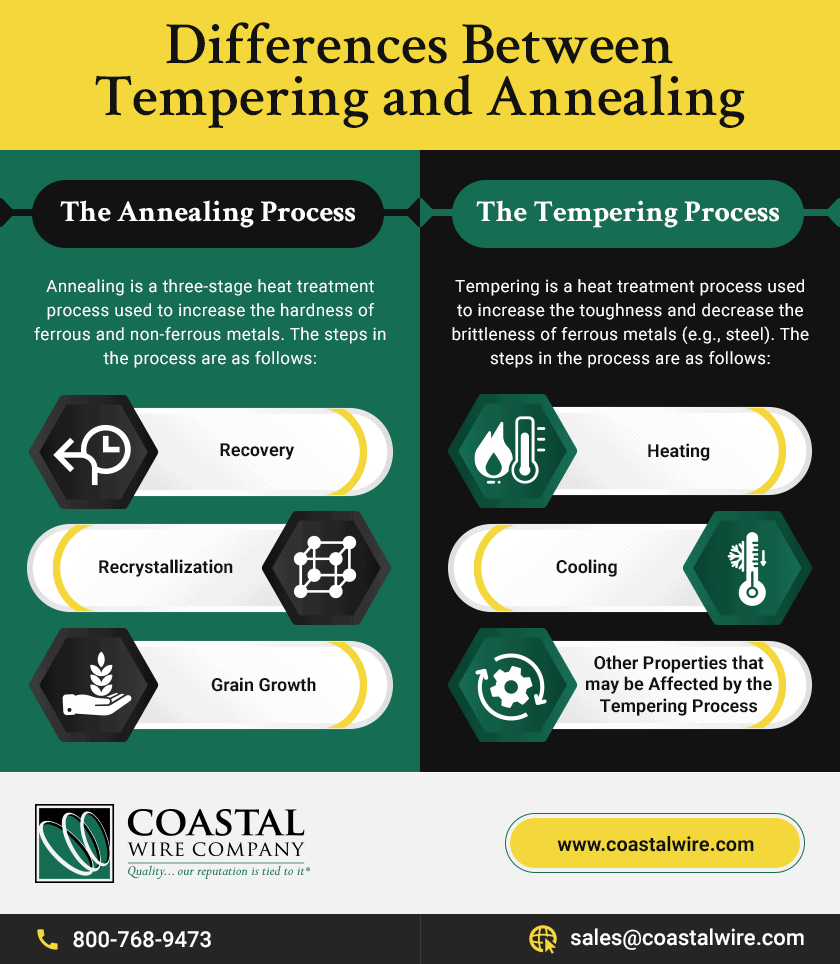Tempering vs. Annealing
Metal workpieces are often heat treated to improve their physical, mechanical, and/or chemical properties to better suit their manufacturing operations and/or intended applications. Some of the characteristics that can be affected include strength, hardness, formability, ductility, malleability, and machinability.
Two of the most commonly utilized heat treating methods are tempering and annealing. Below, we highlight the differences between them as well as typical use cases for annealed workpieces.
Differences Between Tempering and Annealing
The Annealing Process
Annealing is a three-stage heat treatment process used to increase the hardness of ferrous and non-ferrous metals. The steps in the process are as follows:
- Recovery. The metal workpiece is heated—typically by a furnace—to a temperature where the material’s internal structures start to relax.
- Recrystallization. The heated workpiece is heated even further to above the material’s recrystallization temperature but below its melting temperature. Holding the workpiece at this point allows new grains to develop within the material’s internal structure without forming preexisting stresses.
- Grain Growth. The grains that began developing during the previous stage are allowed to fully develop. Carefully controlling the cooling process (i.e., the rate of cooling) ensures the growth of grains results in a less hard, more ductile material.
The Tempering Process
Tempering is a heat treatment process used to increase the toughness and decrease the brittleness of ferrous metals (e.g., steel). The steps in the process are as follows:
- Heating. The metal workpiece is heated to a precise temperature below its critical point. Once the temperature is reached, it is held for a set amount of time. Both the temperature and the holding time depend on the material.
- Cooling. After the workpiece has been held at the proper temperature for the right amount of time, it is quickly cooled in a process known as quenching. Various quenching methods can be used, including immersing the workpiece in water, oil, or compressed air.
Other properties that may be affected by this heat treatment include:
- Ductility
- Hardness
- Strength
- Structural Stability
Products That Benefit From Annealing
Annealing can enhance many properties in a metal. For example, it can increase the material’s strength, hardness, elasticity, formability, or ductility, all of which make it easier to manufacture the desired parts and products and/or improve the components’ performance in the intended applications. That’s why many manufacturers choose to use annealed materials in their production operations.
In the wire making industry, some of the products that are commonly made out of annealed metals are:
- Black annealed wires. These wires are named after their distinctive black color, which is the result of an anti-corrosive surface coating added after the annealing process. They are used in both industrial and consumer applications, such as baling and handcrafting.
- Bright wires. These wires are named after their bright and smooth finish. They are generally used in binding and tying applications.
- Merchant wires. These wires consist of multiple larger coils of annealed wire that are wound onto a stand.
- Box wires. These wires refer to small and tight coils of annealed wire that are individually packed into boxes.
- Tie wires. These boxes are designed for use in tying applications. They generally come packaged as merchant wire or box wire.
Learn More About Heat Treatments From Coastal Wire Co.
Want to learn more about annealing and how it compares to other heat treatments? Ask the experts at Coastal Wire Co. We are a premier provider of high-quality wire specializing in the manufacture of fully annealed, high-strength tying wire for balers. We have the knowledge to answer virtually any question you may have about the process.


